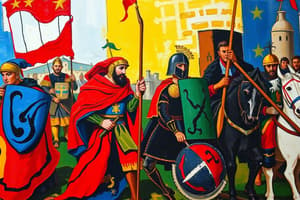Podcast
Questions and Answers
What was the primary basis of the contractual relationship between vassals and lords in the feudal system?
What was the primary basis of the contractual relationship between vassals and lords in the feudal system?
- Religious allegiance
- Military service and support (correct)
- Payment of taxes
- Blood relations
What was the stated goal of the Crusades in the medieval period?
What was the stated goal of the Crusades in the medieval period?
- To reclaim the Holy Land from Islamic rule (correct)
- To establish a unified Christian empire
- To conquer the Eastern Mediterranean world
- To spread Christianity throughout Europe
Which Italian cities strengthened trade ties with ports in the Levant during the Crusades?
Which Italian cities strengthened trade ties with ports in the Levant during the Crusades?
- Naples, Palermo, and Sicily
- Amalfi, Genoa, Venice, and Florence (correct)
- Pisa, Siena, and Bologna
- Rome, Milan, and Turin
What was the duration of the prevalence of the feudal system in Europe?
What was the duration of the prevalence of the feudal system in Europe?
What was the name of the protracted conflict that occurred in medieval Europe?
What was the name of the protracted conflict that occurred in medieval Europe?
What was one of the results of the increased contact with the Eastern Mediterranean world during the Crusades?
What was one of the results of the increased contact with the Eastern Mediterranean world during the Crusades?
What was the main cause of the Hundred Years' War?
What was the main cause of the Hundred Years' War?
What was the impact of the Hundred Years' War on the social structure of England and France?
What was the impact of the Hundred Years' War on the social structure of England and France?
What was the significance of the Battle of Crécy in 1346?
What was the significance of the Battle of Crécy in 1346?
What was the overall impact of the Crusades, trade and commerce, and the Hundred Years' War on Europe?
What was the overall impact of the Crusades, trade and commerce, and the Hundred Years' War on Europe?
Flashcards are hidden until you start studying
Study Notes
Medieval Europe: Feudalism, Crusades, Trade and Commerce, Hundred Years' War
Medieval Europe was a dynamic era marked by political, economic, and cultural changes. This period saw the rise of feudalism, the launching of crusades, the expansion of trade and commerce, and the protracted Hundred Years' War.
Feudalism
Feudalism, a social and political system established in the Middle Ages, was based on a hierarchy of obligations and privileges. It was characterized by a contractual relationship between vassals and lords, where vassals provided military service and support in exchange for land and protection. This system was prevalent from the 9th to the 14th centuries, and it played a significant role in shaping the political landscape of Europe during the Middle Ages.
Crusades
The Crusades were a series of religious wars sanctioned by the Latin Church in the medieval period. These conflicts were launched with the stated goal of reclaiming the Holy Land from Islamic rule. The Crusades had a profound impact on Europe, as they led to increased contact and trade with the Eastern Mediterranean world and contributed to the growth of towns and cities in western Europe. Italian merchant cities like Amalfi, Genoa, Venice, and Florence strengthened trade ties with ports in the Levant, establishing a network of trade routes that connected Europe to the East.
Trade and Commerce
During the Middle Ages, Europe saw a significant expansion of trade and commerce. The Crusades played a role in this development, as increased contact with the Eastern Mediterranean world led to the importation of exotic goods such as silk textiles, glass, and spices. As trade increased, so did the demand for goods, which in turn led to the growth of towns and cities. The Atlantic and North Sea trade routes joined with Mediterranean routes, enabling the transportation of goods across Europe.
Hundred Years' War
The Hundred Years' War was a series of conflicts between England and France over control of lands in France. This long-lasting conflict contributed to the erosion of feudalism in England and France. English monarchs claimed lands in France, which were disputed by French kings. The war saw significant English successes, such as the Battle of Crécy in 1346, where the English defeated the much larger French force thanks to their use of longbows. However, the French gradually chipped away at the territories the English had gained, and when English King Henry V invaded France again in 1415, they faced stronger resistance. The Hundred Years' War ultimately had a profound impact on European history, as it shifted power away from feudal lords to the monarchy and the common people and increased feelings of nationalism.
In conclusion, the Middle Ages was a period of significant change in Europe. Feudalism, the Crusades, trade and commerce, and the Hundred Years' War all played a role in shaping the political, economic, and cultural landscape of the continent. These events and structures left a lasting impact on Europe, influencing its development well into the modern era.
Studying That Suits You
Use AI to generate personalized quizzes and flashcards to suit your learning preferences.




